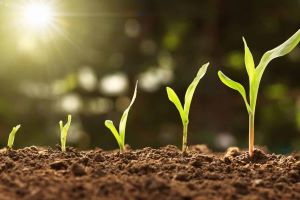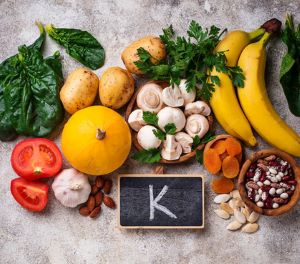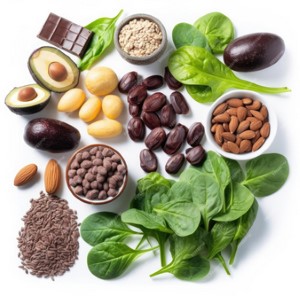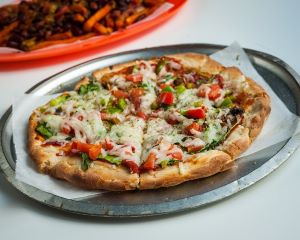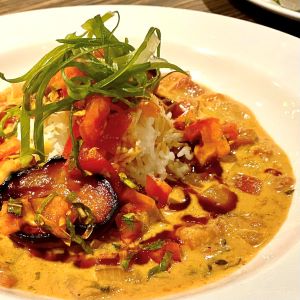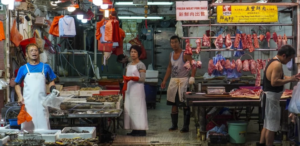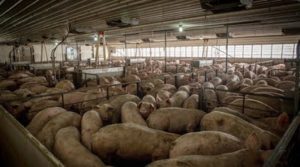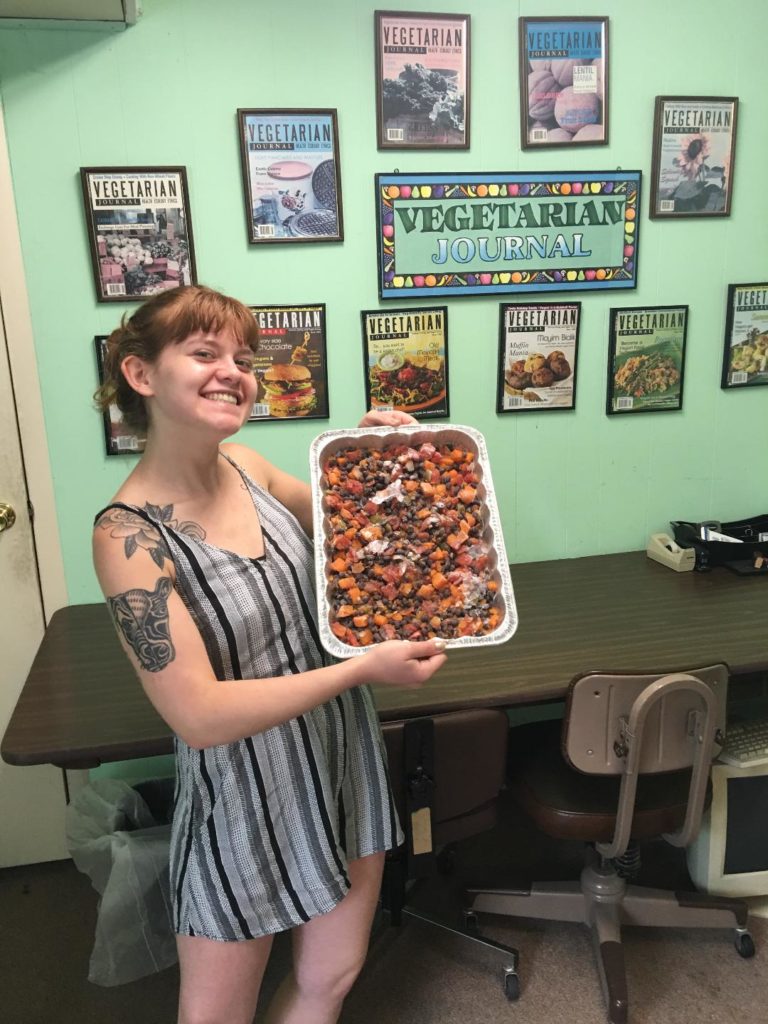Veganic Agriculture as a Climate Crisis Solution 0
By Jeanne Yacoubou, MS
Vegetables are often grown using slaughterhouse byproducts. Fertilizers and soil amendments composed primarily of blood, bone, feather, or fishmeal are common examples, not to mention animal manure.
Unfortunately, even certified organic vegetables have likely been grown in fields literally brimming over with manure from livestock fed pesticide-treated grain. The animals likely have been raised on synthetic hormones or prophylactic antibiotics to ward off disease from close confinement. Although as recent headlines on the H5N1 avian flu virus infecting cows and humans attest, there are no ways to ward off all disease in confined animal feeding operations (CAFOs).
So, what’s a vegan to do? Of course life is about doing doing the best you can within your own situation. Feel good about whatever you do, even if not perfect, which doesn’t exist.
Some individuals will grow their own produce using vegan fertilizers. Since there are plenty of ways to concoct your own DIY vegan fertilizers, you can be 100% sure that what you’re eating is vegan.
Space is not an issue. Vegan gardening works in containers on an apartment balcony, in a raised bed at an urban townhouse, in a backyard (or front yard) garden, or in an open community area. You’ll find a wealth of resources at the end of this article for vegan gardening enthusiasts, both newbies and experienced growers.
But there is another way to get veganically grown food: farms practicing veganic agriculture.
What is veganic farming?
There is no legal definition of veganic farming. Nor is there an agreed upon definition among farmers and advocates who support or practice it for reasons we’ll touch on later in this article. The general consensus, however, is that veganic farming is a way of growing food that does not rely on any intentionally added animal-derived inputs whatsoever.
The phrase intentionally added is included as a part of the definition because some natural, agricultural events, such as pollination, are insect-driven. In fact, without insect pollinators, we wouldn’t have many vegetable crops at all.
Some biocontrol, such as ladybugs flying in on their own accord to eat aphids off of your still-on-the-vine veggies, is also considered a natural, agricultural event that does not make your produce non-vegan. Some vegans, however, may exclude purchasing large numbers of predatory insects and releasing them for biocontrol on a veganic farm because mail-order ladybugs are mistreated, beginning with their being harvested by the millions from the wild using a portable vacuum. They will probably fly away anyway and not eat the aphids in your garden.
Other real-life cases of biocontrol may be hair-splitting to analyze but something to consider when attempting to define veganic farming. For instance, Dr. Eric Brennan has studied biocontrol of aphids by hoverflies in organic lettuce production for over 12 years. He plants alyssum flowers among the lettuce plants. Hoverflies feed off the flowers then lay their eggs in the inner folds of lettuce plants where aphids have infested them.
Hoverfly larvae consume up to 150 aphids per day before they mature enough and fly off to begin the cycle again. The question for veganic farmers and gardeners: Would planting alyssum flowers in your lettuce plot to attract hoverflies be considered a veganic practice?
Is veganic farming also organic farming?
One popular notion of veganic farming (as compared to calling it vegan farming) is that it’s a union of vegan with organic farming. The latter does have a legal definition. The United States Department of Agriculture (USDA) oversees the National Organic Program (NOP) which sets organic standards on growing crops and raising livestock. NOP accredits individuals, companies, and states to certify farms and their products as 100% organic, organic, or made with organic ingredients. Each of these three labels has specific legal meanings.
Using this notion, veganic farming is a type of organic farming that excludes all animal inputs. Based on our research for this article, most growers practicing veganic farming are not certified organic (a costly process that involves much record keeping). However, like certified organic farmers, veganic farmers generally do not use synthetic fertilizers, pesticides, genetically modified organisms (GMOs), sewage sludge, or irradiation.
How many veganic farms are there?
There is a growing number of small farms practicing vegan agriculture in the United States and Canada. Dr. Mona Seymour, who researches veganic agriculture in North America, estimates there are approximately 75 active veganic farms. Most of them are a half acre up to 10 acres in size but a few are 100 acres or more.
Admittedly, animal agriculture dominates food production in most industrialized countries such as the U.S. So, it may be difficult to find vegetables grown veganically near you. But, it’s not impossible.
There are a few websites with maps of veganic farms. Start your search at veganicworld or the VON Map.
Often, veganic farmers sell their produce at farmer’s markets. Visit a few in your area and ask questions. You may hear about growers who are not on the veganic farming maps. If you do, tell them about the maps if they’re looking for customers.
However, based on our research, veganic farmers may not need any more customers unless they expand their acreage, because their food is already in great demand. High-end restaurants looking for produce bursting with flavor and aroma that you just don’t get from vegetables grown with animal manure and synthetic fertilizers are among the biggest customers of veganic growers. In fact, there is a veganic grower in Arizona whose food is so popular that her city gave her land to do more veganic farming!
North American Veganic Certification Standard
Created by Canadian veganic farmer, author, and activist Jimmy Videle, the North American Veganic Certification Standard (NAVCS) is offered to veganic farmers as a way to inspire confidence in their products among purchasers. So far, at the time of writing, approximately 16 veganic farms have been granted certification in Canada, the U.S., and Kenya. At this time, NAVCS is not recognized by any governments.
Biocyclic Vegan Certification Standard
The German-based International Biocyclic Vegan Network founded the Biocyclic Vegan Certification Standard in 2017. This certification is recognized by the International Federation of Organic Agriculture Movements (IFOAM – Organics International). This standard is more detailed than the NAVCS standard but almost identical in basic principles of completely animal-free and synthetic pesticide- and fertilizer-free agriculture that is focused on building soil health. At the time of writing, there are 32 farms certified biocyclic vegan and four distributors of their certified products.
The importance of veganic agriculture as a solution to the climate crisis
The Vegetarian Resource Group has published several articles addressing the multiple environmental and climatic harms caused by animal agriculture. You may find them on our Environment page.
One of the most serious problems of existential proportions facing the human race is the climate crisis. The latest peer-reviewed estimations from 2021, published in Nature, attribute 20% of global greenhouse gas emissions to animal agriculture. Projections (science.org/doi/10.1126/science.aaw9908) using advanced modeling techniques that consider the carbon sequestration by land reverted to natural forests or grasslands if it were not used by livestock boosts that figure to 28%.
This conclusion is strong evidence in support of veganic farming as a climate-imperative replacement of animal agriculture. If the so-called energy transition (from fossil fuels to renewables) were accompanied by a food transition, there would be a 28% reduction of greenhouse gases sent into the atmosphere. There is no denying that this figure represents a significant mitigation of the climate crisis.
Besides this conclusion of already monumental importance, there would be no animal manures full of nitrogen and phosphorus to pollute waterways and contaminate groundwater. A cascade of positive environmental outcomes would emerge from the elimination of toxic algal blooms and the formation of marine dead zones, both caused by excess synthetic fertilizers and manure.
Although veganic farming does require adequate nitrogen and phosphorus as two of the critical nutrients for plant growth, veganic farmers focus on building soil organic matter through various sustainable techniques listed below which significantly limit the amount of additional fertilizers regularly applied to fields by both industrial and organic farmers.
Veganic gardening tips based on veganic farming practices
A garden is a small farm, so many techniques of veganic farmers are directly applicable to veganic gardeners. Differences stemming from the soil type, soil health, weather, and climate of a particular location will determine what your garden needs to thrive, so consulting the resources listed below will help you succeed.
But there are some basic principles to follow in veganic gardening that will yield positive results over time. Keeping in mind the central principle that building the soil is key to growing a productive garden will reap benefits in the long term.
So how can you build the soil veganically? Here are some ways to get started.
1) Make your own compost. This way you can be sure it doesn’t have weed seeds, pesticides, or animal-derived substances in it. Kitchen scraps, including coffee grounds, plus yard “waste” like fallen leaves or grass clippings in a 1:2 ratio is ideal. A compost bin, tumbler, or backyard pile work fine. It may take up to one year to form something that resembles soil (black gold). Once it’s formed, add to your garden plot throughout the year.
2) Use veganic seed if possible. Jimmy Videle, Canadian veganic farmer and author also sells seed through his website. The next best thing is certified organic seed. Choose heirloom or open-pollinated varieties (not hybrids) and save your own seed for next year.
3) Many gardeners advocate rotating crops every season. A 4- to 7-year cycle is optimal. This is a good way to avoid soil borne pathogens. Others suggest intercropping where you plant different crops close to each other for various ecological reasons. For instance, placing companion plants like corn, squash, and green beans next to each other is an indigenous practice which promotes growth of all three sister plants. Another idea is to place related crops, for example, brassicas like cabbages and kale, which are preyed upon by the same insects, far apart from each other to minimize an insect infestation. Planting certain seeds, such as chard or leeks, around the borders of flower beds away from other vegetables and the insects which may be feeding on the latter, will add to your garden aesthetic and reduce insect infestation. Similarly, insects and deer are often repelled by marigolds, basil, nasturtium, and mint, so plant those species around the perimeter of your outside garden and among the rows. Interestingly, insects will flock to nasturtium blooms rather than your vegetables, so that’s a great form of biocontrol. Lastly, allow a carrot or two to flower because they attract insects that would otherwise ravage your garden. See the resources below for other ideas.
4) Draw up a garden map each year. Strategically arrange crops according to sun exposure and soil moisture conditions which could vary even a few feet away. Some crops, like peppers, tomatoes, and squash, need warm temperatures, but others are frost-tolerant and may yield a harvest in 6-7 weeks after planting. Try spinach, radish, bok choy, and baby kale or collards to extend your growing season. Also, although a sunny spot is certainly good for an outdoor garden, a few crops, like lettuces, do well in a shadier location to prevent bolting which turns leaves bitter.
5) For people doing container gardening, biennial crops such as kale or collards will keep on producing edible leaves (as long as you remove one or two per day) for 9-10 months of the year. Chives and other herbs are very easy to grow in pots and will keep on giving as you remove leaves. On the other hand, perennial berry plants do better outside where they have space to grow. Cold temperatures help produce sweeter fruit later.
6) To protect soil microbes, which are vital to growing all plants, do not disturb the soil by turning it over. Hand weed without moving the soil too much.
7) Plant a cover crop (or a mix) after harvest and leave it in place over the winter. That crop is preventing erosion and keeping weeds at bay. Meanwhile, the roots of that crop are pulling up moisture and nutrients closer to the surface to nourish your garden later. Leguminous cover crops add nitrogen to the soil, reducing the need for additional fertilizers. There are many possible cover crops to choose; some do better in certain areas. With certain low-growing cover crops, you could transplant seedlings right into this living mulch. With other cover crops planted in between rows, you could mow it down forming a green manure to suppress weeds from emerging. Cover crops that are killed by frost should be left on the soil to protect and nourish it through decomposition. Consult the resources below for more information.
8) In early March before planting, do a basic soil test to determine nutrient levels. The resources below will have a listing of reputable labs. Use your county’s extension agent for additional tips. At this point, apply additional compost if needed, as dictated by soil test results.
9) Sow large seeds directly into the plant residues remaining over the winter. For small-seeded crops, start seedlings indoors in late February under proper lighting or in a heated propagator. Use a soil mix containing your compost or a veganic soil starter mix. Transplant seedlings into the plant residues once the seedlings are 4-6 inches tall and the soil temperature is 55-60ºF.
10) Agroforestry incorporates trees into agriculture to create a system that mimics natural ecosystems. This practice could work in outdoor gardens. To minimize the chance of small mammals from nibbling your fruit tree roots, plant daffodils or mint around the base of trees to deter them. To prevent birds from eating the fruit, a fine mesh netting over the tree is recommended. Note that the netting would also prevent birds from eating any insects that may also be feeding on the fruit.
11) Every 3-4 years, leave your garden area fallow (don’t plant). This gives the soil a rest. Continue to keep it covered with compost, wood chips, fallen leaves, etc. to continually enrich the soil. Consider gardening somewhere else in the meantime.
Veganic farming and gardening resources
There is a wealth of information online. If you’re new to veganic farming or gardening, these resources will prove to be invaluable.
- Seed the Commons webinars with veganic farmers and supporters of the veganic food movement are full of useful information.
- Veganic Agricultural Network is for veganic gardeners and farmers as well as people looking to purchase produce grown veganically. The founders offer an online veganic gardening course and host the Veganic Summit.
- Stock-Free Farming is based in the UK but a plethora of case studies are applicable to the U.S.
- Veganic Organic Network, also based in the UK, has a variety of programs, especially for schools, to promote veganic agriculture.
- All of the products at One Degree Organics are veganically grown. Two items contain honey. To the best of our knowledge, this is the only online company rooted in veganic agriculture.
- The Veganic Grower’s Handbook by Jimmy Videle is one of the best veganic agriculture reference books.
- The Sustainable Agriculture Research and Education (SARE) program, supported by the USDA’s National Institute of Food and Agriculture, publishes two manuals that would be helpful to veganic gardeners and farmers: Managing Cover Crops Profitably and Crop Rotation on Organic Farms.
- On The Vegetarian Resource Group website: Veganic Farming Resources
The contents of this posting, our website and our other publications, including Vegan Journal, are not intended to provide personal medical advice. Medical advice should be obtained from a qualified health professional. We often depend on product and ingredient information from company statements. It is impossible to be 100% sure about a statement, info can change, people have different views, and mistakes can be made. Please use your best judgment about whether a product is suitable for you. To be sure, do further research or confirmation on your own.
